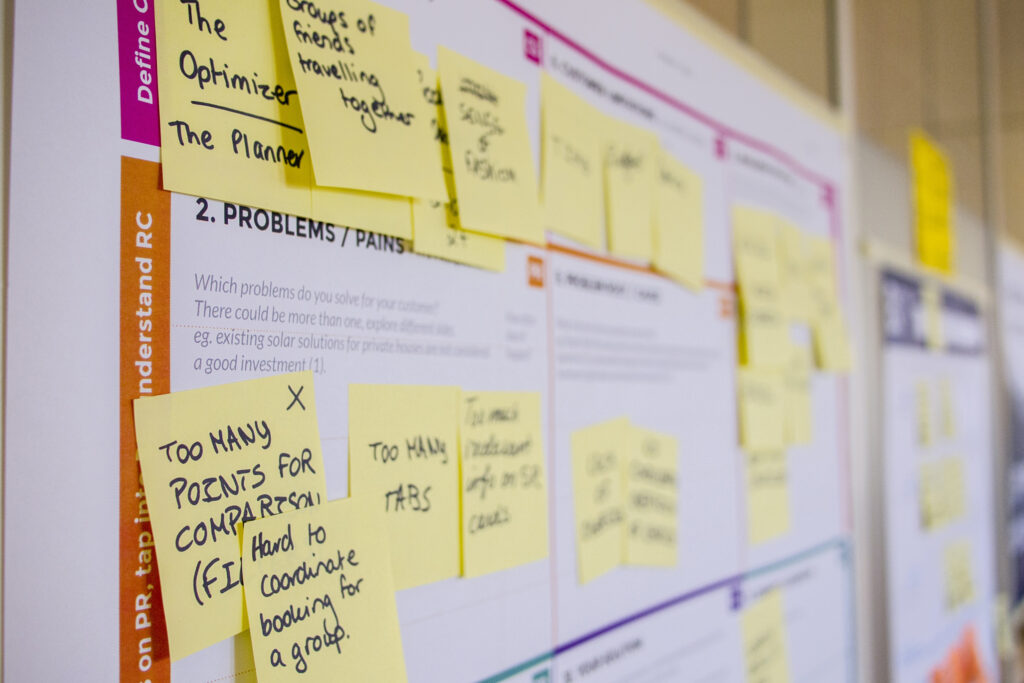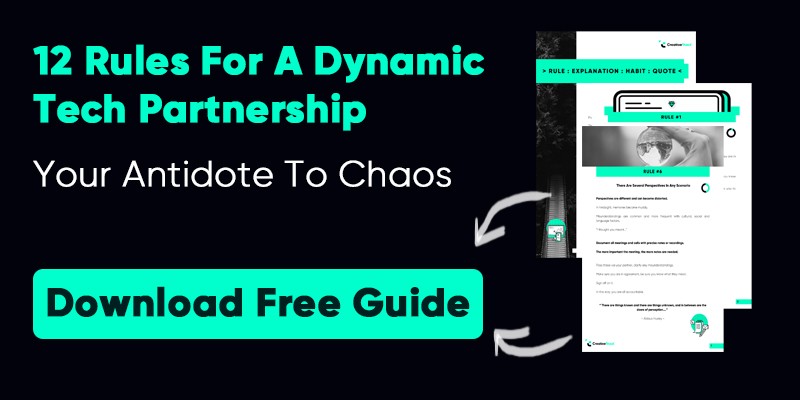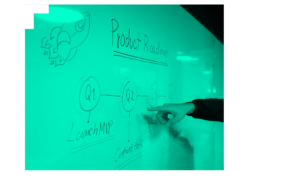
Scaling your agency with a modern technology partner. Simple? Not quite…
If you choose the right partner after considering this comprehensive guide, it will be.
Many partnerships fail, a lot of people are sold on cheap offshore providers and the result can be quite a daunting mess. Understandably, this puts a lot of people off – even if they’ve only heard about other people’s experience with technology partners.
So, what do I need to know to make sure I get the right tech partnership for my business?
How can I make sure my choice of technology provider, their team, process, and management work to grow my business with a pipeline of new clients and modern tech projects?
Looking For A Tech Partner?
That’s why I’ve written this guide to get business sense and harmonious relationships reinstated into the software development industry.
We need expert tech solutions that put relationships first, provide ongoing flexibility and champion quality – In all processes – to produce working, innovative software.
Ready to make any tech partnership work? Check out this free guide!

Loaded with technology debt from the get-go?
Frustrated by tech projects that exceed budgets with stretched timelines and missed deadlines?
These are all too common….
Why?
Without being too explicit, there are ruthless and desperate people out there.
They care only for themselves or cannot conceive the wellbeing of others.
A lot of software development happens via long-distance – away from human contact and understanding. It’s simplistic to state this, but; phone or video calls can only convey so much about a particular person. This is a problem when you need to build a partnership that helps to scale your agency in the long term.
So…
Start. With. People. Not Solutions. Please!
My other two points:
→ People = Relationships & Innovation = Hardware ↔ Software → Wellbeing ↔ Productivity → Connection → ∞
That’s why relationships are my focus: I believe in ongoing harmony with my kin – friends, family and our team. Connection enriches my life, honesty builds me up and transparency gives me realistic goals – to be aligned with my people. They are experts in ‘me’, and in-turn; ‘I’ in them.
I find purpose through this. It drives me to become the highest version of myself and see the best in others. I teach to help, I aim to inspire.
Through that, I make life a transcendent game of innovation backed by belief in the best of humanity.
This ethos is reflected in our work: we believe in challenging the status quo. We do so by improving upon all relationships. Yes, even the worst of them – we all have something to learn from those.
Everyone needs people who believe.
Creating for our environment, the joy in our work, our partners, and – most of all – ourselves; so we can continue with the energy to start this cycle anew.
We choose to help when others will not.

Together, everyone achieves as we rise up to build innovative software.
Why Do Tech Partnerships Fail?
Stories of manipulation and poor practice are coded into the fabric of unstable tech partnerships. Sound familiar?
Many clients come to us with the false belief that outsourcing tech is foolish. This is understandable: false promises, scope creep and lack of proper planning undermine our entire industry.
Once burned, twice shy. But why?
Simply, many providers are cheap imitations of quality. They prey on your lack of tech expertise and your desperation for a solution. You become a transaction. There’s no relationship in that kind of ‘partnership’.
The world does not need any more conglomerate corporates who feed off each other in back-hand business and only see in green. They are disenchanted lost souls and it shows. The result?
Gimcrack apps, poor platforms and mounting frustration.
These products are a false economy: many businesses are left treading water, exceeding budgets – and then – discovering that their ‘modern’ tech solution is outdated.
Worse still, lots of these software companies have hidden fees or quit without any consideration for maintenance..! What kind of a business model is that?
The fix? “Give us more to fix your (sic: our) problems.”
In the end, an external audit is required.
A complex manual is needed for an ‘inuitive’ user-friendly platform.
The rage is palpable.
Communication breaks down.
Never again!

What Makes A Good Technology Partner?
On behalf of our industry, let me guide you back to clarity:
All technology partnerships must support you. They must provide peace of mind too.
These partnerships aim to empower both parties. They provide the space, energy, and time that you need to innovate; to look after your team, and focus on what you do best – your brilliance, your core offering.
Find good ideas and make them great.
We do the rest, we are proud of that.
You breathe a sigh of relief. The darkness lifts.
In this relationship, adept programmers are present from the very beginning.

These chaps ensure you are the right client for them. Yes – these developers may come back with a strong ‘no’. It’s called integrity. If you aren’t ready to scale, they will not lead you on. Frankly, they will give you free advice to find clarity – to take steps towards readiness – but that’s it.
We are not here to sell products or services, we are here to consciously transform ourselves first, and through that, create for our environment and our world.
Crystallised your purpose with a plan?
Carved out time to commit to gaining insight from experts by forming a tech partnership?
It’s evident if you have.
Only at that point will you get full attention and consideration. Why? Integrity. Which also stipulates that set protocol and procedures are followed from the beginning.
After all, It’s the beginning of what could be a long-lasting partnership.
We’re aiming for new clients and a pipeline of projects that help to scale your agency.
So, we would prefer to be transparent.
Together, we can strive to create a relationship based on trust and craftmanship – good people deserve these, and so do your new clients.
Why Play With The Little Time We Have?
Integrity empowers us, it is the core of harmonious relationships. It’s also common sense – if you aren’t prepared and can’t commit time to add context in discussions – being transparent with your problem – why would someone offer to help? After all, they would be providing a false fix by addressing 1/2 the problem!
We uphold this value system of honesty and transparency from idea to implementation.
Hereafter, problems become solutions.
The right partner will work with you to understand your history, current challenges, inspiration, and purpose – your ‘why’. Being sure to add value with context, expertise, and realism.
Shortly after, they set to building a foundation that will be ready for your ongoing requirements: scalable, dedicated resources, project management, and an applied process that takes account of your agency’s long-term goals.
Utlimatley delivering feasible solutions which incorporate your needs.
At the right time, they are there to take care of you. No matter what.

This process occurs at a fixed price and within a fixed timeframe.
It also strikes a balance between #1 time, #2 quality and #3 cost.
Equilibrium is maintained.
Yet, no one can equally fulfil wishes ~#1 #2 & #3, not even on an Arabian Night.
Ultimately, your partner’s business procedures consider your stability and your ultimate priority – #1, #2 or #3 – in each project. It’s in the balance, so clarity is pragmatic. For all our sakes.
Such a relationship is conducted with transparency and clear, consistent communication through set channels with assigned specialists from the beginning. Everything is outlined and agreed on.
All proceedings are signed off on by the right people from both parties.
There is a rigorous documentation process to govern and support the ongoing software development operation. There are no surprises, although there will be compromises – for both parties – as innovation requires flexibility.
Even then, everyone is buoyant and on the same page.
The measure of progress? Momentum is maintained alongside benchmarked software which incorporates your ongoing requirements to produce working prototypes.
These are followed-up with beta-tested, approved, launched and useable platforms that reflect your ideals.

The core of your brief is intact, the rest is reimagined beyond belief – it’s working quality delivered by developers who enjoyed the experience: working with you.
— Yes, that’s how it works when masters of the craft are involved! —
It’s a proud moment.
- An innovative solution arrives that considers the future of your business.
- Your relationship is more than intact, in fact; it’s blossomed to the point where you can recommend this team of developers. Perhaps even friends by this point?
- They also offer ongoing maintenance from the same experts you know, who know you. Foresight.
- This application, platform, or system helps you to attract new clients and scale your agency.
- These new clients want your services, and our business model lets you pitch for every complex technology project that lands on your plate – we are ready to provide a fast turnaround and solution estimate, scalable resource, and project management whenever you need it.
- You can rest assured that you’re on the right path.
This tech partner worked with you, they built this as a testament to your relationship.
Yet, many people are pulled in, treated as transactions and misled by software companies. Why?
They don’t know the difference between:
An app and a booby trap.
A framework and some artwork.
Tech language and a club sandwich.
So, what’s the difference between a good partnership and a rotten deal?
What To Look For In A Technology Partner
First, connections: where would you find any reputable business: reputable sites.
These show their capabilities to the core of their business offering with links to their partners. Preferably reviewed, recommended and verified.
Clutch, LinkedIn, Google Business Profiles and local industry-specific sites, such as Wired Sussex, are good starting points.
Ideally, cross-reference everything. No time? Prepare to be ripped off.

Top 10 to Avoid!
- Ambiguity around their process – a mechanism in flux or lack of one altogether.
- Inconsistent communication – disordered priorities or too many plates in the air.
- Bold claims that are not backed with evidence, such as a shortage of dated and verified case studies – untrustworthy.
- A lack of domain-specific knowledge – generic skillset which is not applicable to solve your problem in a way that counts.
- Absence of industry-specific technology knowledge – insufficient expertise.
- Inability to explain complex technical terminology in a simple way – unrelatable and unable to coach you through the process of development. Probably impersonal and unrealistic too.
- No clients of a similar size? They couldn’t cope with one project, let alone scale your agency.
- The leader is aloof and unable to demonstrate inspiring prowess in conversation, let alone back it up with fact. Imposter syndrome and lack of ability are not a good combination!
“The speed of the leader determines the pace of the pack”
– R.W.Emerson.
- No simple contact form? Left it all up to you? There’s too much to do as it is. Overwhelm.
- Inconsistency in marketing and branding across multiple platforms – poor understanding of reputation, general disorganisation.
⇒ Their talk and marketing is – sales – pitch – hook – line – sinker.
Check 5/10 of these and they are bankrolling you.
Money > Relationships.
What To Look For:
Find a leader who stands for something important. It’s not money! It’s relationships that build quality software. With luck, it’s for the good of all.
Their angle: they help people stay up to date in an ever-changing technology landscape. They teach, they aim to help.
They work to empower you with tech.
Above all, they want your business to succeed.
This process inspires them.
Why? Find out in this free download:

Teams with a cohesive and professional structure, members who reference each other in their bios?
They stand for a purpose. They work with each other. Their ‘why’ is as clear as a day, their capabilities as long as a summer solstice.
In a bio, look for humility balanced by fact. If so, someone in their team wrote it as a gift.
Also, always look for experience.
Battled hardened professionals have tried and tested their methods over many years.
Those case studies represent this companies commitment, talent and – in most cases – their flexibility and domain-specific knowledge.
If this happens to translate across many industries (verticals), well, that’s exceptional.
A company that reflects their prowess in prose as well as working software? They care about their reputation, they proudly put their stamp on everything they do and explain their technical knowledge fluidly.
Understood by all.
“Simplicity is the ultimate sophistication”
– Steve Jobs.
News: it’s current and specific. Blog: it’s wicked witty and regular, yet easy and informative at once. Divisive expert opinions too? Commenting on trends, weighing in with a reasoned opinion?
Data and research to back it up? Check.
Clients of a similar size and projects with a relatable scope? Realistic timelines? Yes!
Their talk: value driven, purposeful and succinct – they know your time matters.
In your conversations, you feel their process-driven productivity. It accounts for your ideals – your meetings matter.

When approaching a problem, you find your value system mirrored. Their thought process is a uniquely inventive perspective that seeks to understand and yet it compliments your own thoughts. It’s cohesive, inspiring and strikingly modern.
It’s something you could learn to work with long term.
Think: this company get’s me, they are going to help.
They are personable, human-centric and kind? Time to talk? Of course.
Set scheduled meetings weeks in advance? They know the value of taking away that extra stress. Sent you a reminder too. Ah yes.
Self-accountability. They know the value of apologies, they sincerely want to work with you and make compromises to do so.
Now you can be sure that this potential partner has the ability to manage your business requirements.
Relationships > Money.
A strategic technology partnership built to last.
To paraphrase E.O Wilson:
Are you still.. “drowning in information, while starving for wisdom?”
How Do I Choose A Technology Partner?
Choice is overwhelming at the best of times.
Let alone when the stakes are high and you need a tech solution fast.
So, here’s a top 6 plus 3 quotes for finding the right fit.
Often, a brief meeting is the best way to tease these apart:
“If you can’t describe what you are doing as a process, you don’t know what you’re doing”
— W.Edwards Deming.
- (Process) They have one. It’s out in the world for all to see. It’s worked for the rest of their clients. You imagine this mechanism working with your business plan and timelines.
- (Inclusion) Are you invited to be involved in this process from the beginning? How are they going to make sure you are included?
- (Explanation) Has anyone explained why the process works, why it’s repeatable – in layman’s terms?
- (The Vibes) Does this potential partner feel right?
- You need some resonance to ensure your values align: agreement on worldly issues and ethics talk on pressing subjects. Some engaging charisma and kindness too, perhaps?
“Passion pursued with consistency and intention of helpfulness goes so much further and opens doors you cannot imagine”. — Deeksha Arora
- (Consistency) Is their spirit and essence of why they do what they do present in all of their messaging: is it apparent in case studies, testimonials and their blog?
- If so, it is clear you will be treated with respect. The outcome of this partnership will be no different than their past clients’ success. It’s forged as a union – a lasting relationship.
They made people feel right.
It’s the genes, the team culture, their attributes and, finally, consistent outcomes.
It all points to reliability.
“When you’re known for being value-driven, you attract more than you envision.”
— Adeyemi Taiwo Eunice
- (Value). Are you receiving free advice when the company does not consider you ready? Some value must be provided upfront without the need for payment.
It’s the right thing to do!
Process: Inlcusion & Explanation: The Vibes: Consitency & Reliability = Principles & Value Upfront.
By qualifying this potential technology partner with logic and then using your intuition you will be able to decide in 20 minutes.
Check out our other article for more information:

Trust yourself.
⇒ Your questions have been answered more than adequately, you can envisage this process working for you – you understand what will happen and why.
You must have felt uncomfortable with my writing so far. That’s exactly what you needed – the truth. Re-evaluating priorities and taking time in any big decision is important.
I want you to succeed.
“The most difficult thing is the decision to act, the rest is merely tenacity. The fears are paper tigers. You can do anything you decide to do. You can act to change and control your life; and the procedure, the process is its own reward.”
— Amelia Earhart
If you’ve made it this far, congratulations!
It’s time to talk logistics and management: how does all of this human-centric relationship talk add value to a quantifiable, working technology partnership?
How To Structure A Tech Partnership
We all want to drive growth and encourage innovation to build incredible digital products.
Self-belief, structure and planning come first.
Now you’ve decided on who to approach, clarity is required on your end. I’m sure you have some already. Perhaps you are not as precise and transparent as you think?
“Check out your own back yard before you check out someone else’s”
-‘Hercules’, Aaron Neville.
[Business Objectives]
- Be confident to articulate what you need.
- Be clear on your business objectives.
- Be certain of your absolute priority.
- Be transparent with your requirements.

How? Tough questions first:
- What is your positioning? This is about differentiating yourself from your competition.
- Outline your thoughts in writing. Take time.
- Use diagrams, quotes and images too. Not ‘perfect’, just rough.
- Q’s for inspiration: How did you get here, where are you going? Why?
- Prepare to show these inspiring reflections, stand in your vision. It all really helps any tech company understand your story.
- Your audience/market: why are they going to benefit from this tech product?
- Tell yourself your story out loud (only then are you hearing it). Fresh perspective.
- To find the crux of the problem you want to solve, talk it through with your friends.
Then, explain it to a novice. Shortly after, explain it to your team – the experts in you. - This builds your confidence to articulate what you need at varying levels of complexity.
“It is better to solve one problem five different ways than to solve five problems one way.”
― George Pólya
- Clarify your ultimate priority: remember which of #time, #cost or #quality are most important. Pick 2. Then, narrow it down to your one true need.
- Understand what stage of the business life cycle you are in.
- Consider if your goals are pragmatic. Look at the big picture. When do you really need this finished? Are tolerances built into your ideals?
- With your team, have you considered who needs to do what and by when to have all the documentation in order and clearly filed in one place? Be ready.
Here’s Our Technique For Putting This Into Action:
— Preparation —
[Consider] before
- Be ready with your ideas and be flexible with your needs.
- Believe in solving this problem.
- Believe in your choice of partner and their ability.
- Remember, you are not an expert in this type of solution – prepare to listen.
- Take your problem to your potential partner.
- Prepare for an open discussion.
— Meeting Commence —
[Communicate] during
- Be transparent about what you need, lay the problem bare.
- Explain how you ended up here.
- Clarify your ultimate priority.
- Explain why! it resonates!
⇒ This demonstrates you have put the effort in to find clarity.
- Talk through a plan.
- Take notes.
- Circle back on the plan and notes!
— Meeting end —
- Reaffirm points and plan via email.
[Think] afterwards.
- Serious decision making is mostly subconscious, give your brain time to play Tetris.
- Do not rush: take a minimum of 2 hours to focus on something else.
[Decide] after rest.
- Beverage break.
- Chat with a mate.
- Make a decision.
— Decision Made —
⇒ Even if it’s a no, you are now in a position to take this material to anyone you wish.
You are empowered with ultimate clarity.
Business Objectives [Plan] → Consider [Before] → Communicate [During] → Think [After] → Decide [After Rest].
I hope you can see how many partnerships fail: lack of clarity, integrity, and an abundance of insincerity in opaque discussions are the 4 horsemen here.
Not to mentioned rushed decisions on tight budgets…
Congratulations!
You are on your way to building a dynamic, successful technology partnership.

The self-belief is there. The effort required from both parties is clear.
The process is orderly. The documents are ready. The plan has come together.
The required outcome and roadmap is pragmatic.
However, this is just the beginning.
Relationships are just like partnerships, they take work to get off the ground. Thereafter, maintaining cruising altitude requires management and compromise.
Most executives do not foresee turbulence and hit autopilot…
Technology Partnership Strategy: How To Manage A Tech Partnership
Consistent habits build businesses and forge powerful partnerships.
Are you going to leave it to chance?
Find out in with this free resource:
Responsibility & Accountability
- Things are going to go wrong.
- If you are going to criticise anyone, be sure that your house is in order.
“The man who complains about the way the ball bounces is likely to be the one who dropped it”
— Luo Holtz.
- Be real: have some kind of flexibility and self-accountability – everyone is responsible for their own mistakes in a successful tech partnership.
Mistakes are part of any human process, and they are ok!
Compromises and apologies are essential. - The cornerstone of accountability: transparent communication and documentation.
Transparency
“Honesty is the first chapter of the book ‘wisdom’.”
— Thomas Jefferson.
- Don’t expect loyalty when you can’t provide honesty.
- Do not hide half of the problem.
- Managing scope creep and change requests: what is the process?
Communication
- Ensure communication through set systems, protocols, and people…that you stick with!
- And, not too many of them! Slack, Email, Notion, Gdocs, Text, Dropbox, Phone Calls, Zoom, Google Meet, Whatsapp? No wonder you are lost and tired.
- Do not mix protocols and processes on the same channels. For example, if you are using Slack for day-to-day chat, do not send important documents which need signing off on through that channel.
Stick to email sent to a designated person for important checks. This also saves time! - In its simplicity, we suggest: Slack for day-to-day, email for important documents, zoom for meetings, and notion for a project workspace.
- Hold meetings with the right people: save time and energy. If people don’t need to be involved, do not involve them. It’s a waste of resources.
- Discussion points: always circle back on discussion points to ensure everyone is on the same page.
- Keep to set meeting schedules.
- Maintain contact and set hours.
- Keep communication channels open.
All is clear, and everyone is open to discuss as things progress.
Documentation
- Having a phone conversation or a video call? Document or record the discussion so everyone is accountable for what is said – any agreements in every meeting. Circle back. Pass it to your partner. Look over it. Clarify if needed. Sign off on the understanding. This way, everyone is in complete agreement.
- Are you logging the project progress as we fault-find and identify bugs? Please do.
In this way, the trail can be traced and each partner can be held accountable.
- A contract is your last resort. Yes, it’s an important failsafe – but it’s just that – a failsafe. Trust, transparency and consistent communication build relationships above contracts.
- This prevents conversations from becoming a finger-pointing exercise.
There is no ambiguity in why things happened, what the results were and how changes transpired.
Project Manage + Update + File
- Must I say this: project management!
- Everyone knows what they have to do, and when to do it to maintain a critical path.
- The actionable tasks and sub-tasks are up to date.
- The calendar is maintained.
- The documents are in the right folders.
The high-level managers are on the same page, in both companies.
Benchmarking
- How to know you are on track: process, protocols and aligned schedules.
- What is delivered versus what was specified? Discuss: sign off.
- You can look at that in terms of cost, time and quality.
⇒ It’s checked against both companies quality control: It works as was agreed!
What to do if shit hits the fan?
- You already know who you are in bed with (many don’t!).
- Follow the protocols: there is a set process to deal with setbacks and changing requirements. These are tolerances you have built into the system – use them first!
- What places any successful partnership above the rest is how people react in times of turmoil. Lead by example. Exercise respect above all.
- Everything is easy, everyone is aboard the gravy train – riding the highs in the market. As soon as the market changes it’s “I can’t afford to bring the weed to the party, no keg either”.
- Honour your agreements, there’s no integrity otherwise.
- Contract – the last resort. Lawyers? Surely not. No one likes that bluff, let alone believes it.
Things are going to go wrong, plan for that.
When they do, consider: would changing the supplier solve this problem or do I need to be honest with myself about how I operate?
In any event, at least you can have an open conversation about key issues – you have the documentation, management process, business strategy, and an honest technology provider. The four ingredients to get your digital product back on track.
Responsibility & Accountability → Transparency → Communication → Documentation + Project Manage + Update + File → Benchmarking = Measured results from a partnership built to last.
You are ready.
Let go of your worries and scale your agency fast
Check out our ’12 Rules For A Dynamic Tech Partnership’ for more information on successful habits that forge effective tech partnerships.
Outcomes:
- Trust and Communication Maintained = dynamic and reliable partnership.
- Innovation Encouraged = agile principles and cutting-edge tech.
- Focus Regained = pivot back to your core, what you do best!
- Longevity Established = ongoing and flexible partnership.
- Tech Solutions Delivered = UX and UI working with people.
- Growth-Driven = agency growth from new clients & a pipeline of tech projects.
- Reassurance = ongoing partnership and maintenance.

Image References:
1. This Must Be The Place To Scale Your Agency – Tim Mossholder.
2. The Strategic Business Models You’ve Been Looking For – Austin Chan.
3. In Lifting Others We Rise To Gain New Clients – Brett Jordan.
4. Angry Phone Call – Icons8 Team.
5. Scaling An Agency – Peter Gombos.
6. Teamwork, Digital Tools, Technology Products – YouXventures
7. Project Management In Tech Partnerships – raeng.
8. Long Term Planning – Scott Graham.
9. Tech Meeting Scaling An Agency – Austin Distel.
10. UX Planning – Alvaro Reyes.
11. This Must Be The Place – Tim Mossholder.
12. Business Models – Daria Nepriankhin.
13. New Clients From Tech Partnerships – raeng.
14. Be The Change Long Term – Brett Jordan.
15. Scaling An Agency – Fab Lentz.




